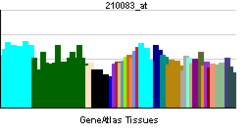SEMA7A
| View/Edit Human | View/Edit Mouse |
Semaphorin 7A, GPI membrane anchor (John Milton Hagen blood group) (SEMA7A) also known as CD108 (Cluster of Differentiation 108), is a human gene.[3]
SEMA7A is a membrane-bound semaphorin that associates with cell surfaces via a glycosylphosphatidylinositol (GPI) linkage. SEMA7A is also known as the John-Milton-Hagen (JMH) blood group antigen, an 80-kD glycoprotein expressed on activated lymphocytes and erythrocytes.[supplied by OMIM][3]
Genetics
This protein is known to have eight variants in the extracellular region: seven lie within the Sema domain and one within the PSI domain.
Molecular biology
This protein forms dimers.
Notes
This protein acts as a receptor for the malaria parasite Plasmodium falciparum.
See also
References
Further reading
- Xu X, Ng S, Wu ZL, et al. (1998). "Human semaphorin K1 is glycosylphosphatidylinositol-linked and defines a new subfamily of viral-related semaphorins.". J. Biol. Chem. 273 (35): 22428–34. doi:10.1074/jbc.273.35.22428. PMID 9712866.
- Lange C, Liehr T, Goen M, et al. (1998). "New eukaryotic semaphorins with close homology to semaphorins of DNA viruses.". Genomics. 51 (3): 340–50. doi:10.1006/geno.1998.5256. PMID 9721204.
- Yamada A, Kubo K, Takeshita T, et al. (1999). "Molecular cloning of a glycosylphosphatidylinositol-anchored molecule CDw108.". J. Immunol. 162 (7): 4094–100. PMID 10201933.
- Angelisová P, Drbal K, Cerný J, et al. (1999). "Characterization of the human leukocyte GPI-anchored glycoprotein CDw108 and its relation to other similar molecules.". Immunobiology. 200 (2): 234–45. doi:10.1016/s0171-2985(99)80073-4. PMID 10416131.
- Tamagnone L, Artigiani S, Chen H, et al. (1999). "Plexins are a large family of receptors for transmembrane, secreted, and GPI-anchored semaphorins in vertebrates.". Cell. 99 (1): 71–80. doi:10.1016/S0092-8674(00)80063-X. PMID 10520995.
- Mine T, Harada K, Matsumoto T, et al. (2000). "CDw108 expression during T-cell development.". Tissue Antigens. 55 (5): 429–36. doi:10.1034/j.1399-0039.2000.550505.x. PMID 10885563.
- Holmes S, Downs AM, Fosberry A, et al. (2002). "Sema7A is a potent monocyte stimulator.". Scand. J. Immunol. 56 (3): 270–5. doi:10.1046/j.1365-3083.2002.01129.x. PMID 12193228.
- Strausberg RL, Feingold EA, Grouse LH, et al. (2003). "Generation and initial analysis of more than 15,000 full-length human and mouse cDNA sequences.". Proc. Natl. Acad. Sci. U.S.A. 99 (26): 16899–903. doi:10.1073/pnas.242603899. PMC 139241
 . PMID 12477932.
. PMID 12477932. - Ota T, Suzuki Y, Nishikawa T, et al. (2004). "Complete sequencing and characterization of 21,243 full-length human cDNAs.". Nat. Genet. 36 (1): 40–5. doi:10.1038/ng1285. PMID 14702039.
- Gerhard DS, Wagner L, Feingold EA, et al. (2004). "The status, quality, and expansion of the NIH full-length cDNA project: the Mammalian Gene Collection (MGC).". Genome Res. 14 (10B): 2121–7. doi:10.1101/gr.2596504. PMC 528928
 . PMID 15489334.
. PMID 15489334. - Maurin JC, Delorme G, Machuca-Gayet I, et al. (2005). "Odontoblast expression of semaphorin 7A during innervation of human dentin.". Matrix Biol. 24 (3): 232–8. doi:10.1016/j.matbio.2005.03.005. PMID 15907379.
- Hu Y, Malone JP, Fagan AM, et al. (2006). "Comparative proteomic analysis of intra- and interindividual variation in human cerebrospinal fluid.". Mol. Cell Proteomics. 4 (12): 2000–9. doi:10.1074/mcp.M500207-MCP200. PMID 16199891.
- Koh JM, Oh B, Lee JY, et al. (2006). "Association study of semaphorin 7a (sema7a) polymorphisms with bone mineral density and fracture risk in postmenopausal Korean women.". J. Hum. Genet. 51 (2): 112–7. doi:10.1007/s10038-005-0331-z. PMID 16372136.
External links
- SEMA7A protein, human at the US National Library of Medicine Medical Subject Headings (MeSH)
- John Milton Hagen blood group system in the BGMUT blood group antigen gene mutation database
This article incorporates text from the United States National Library of Medicine, which is in the public domain.
